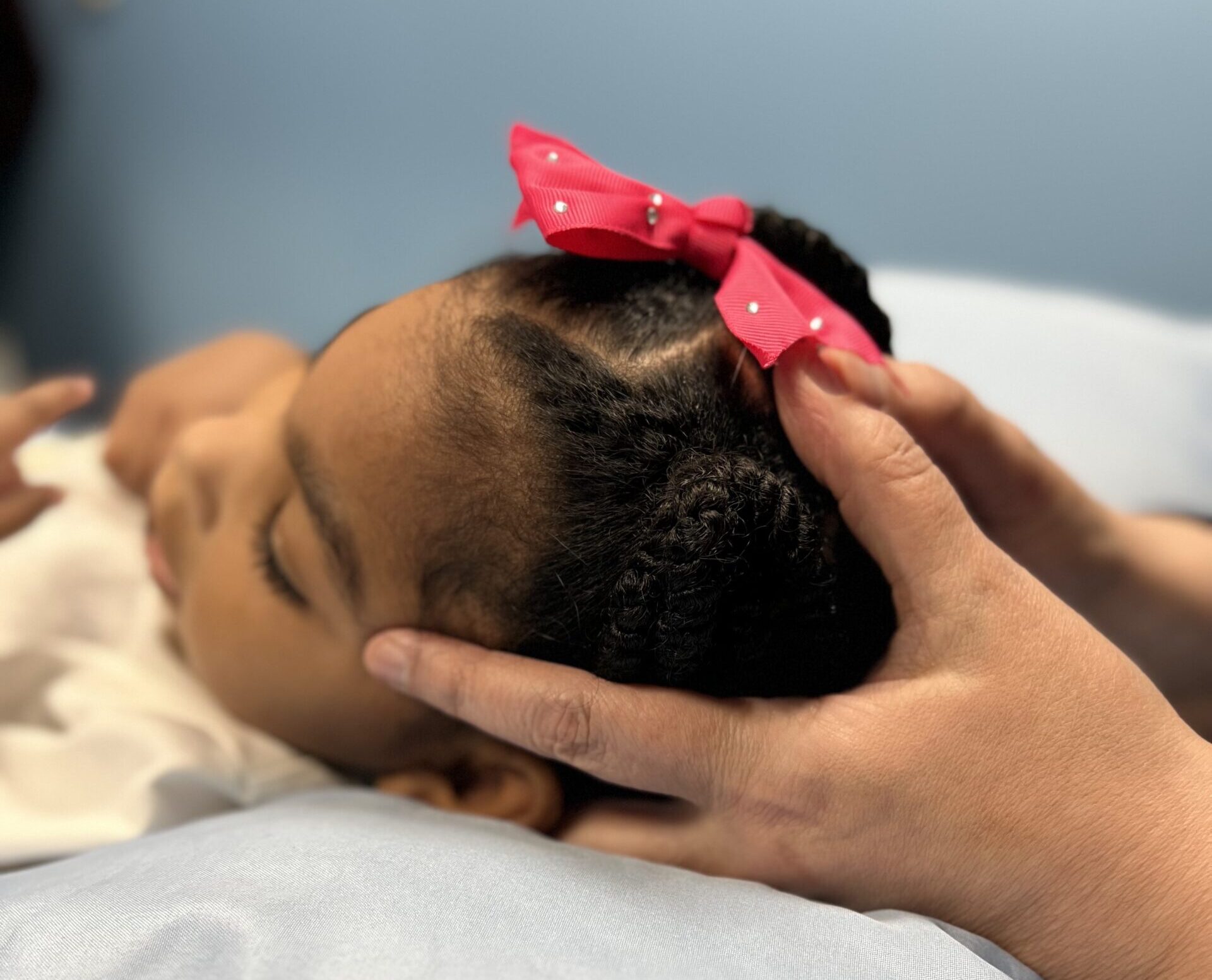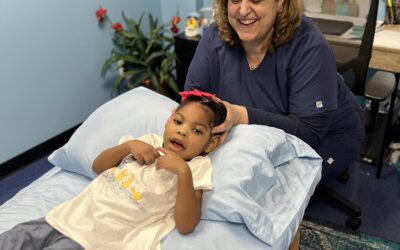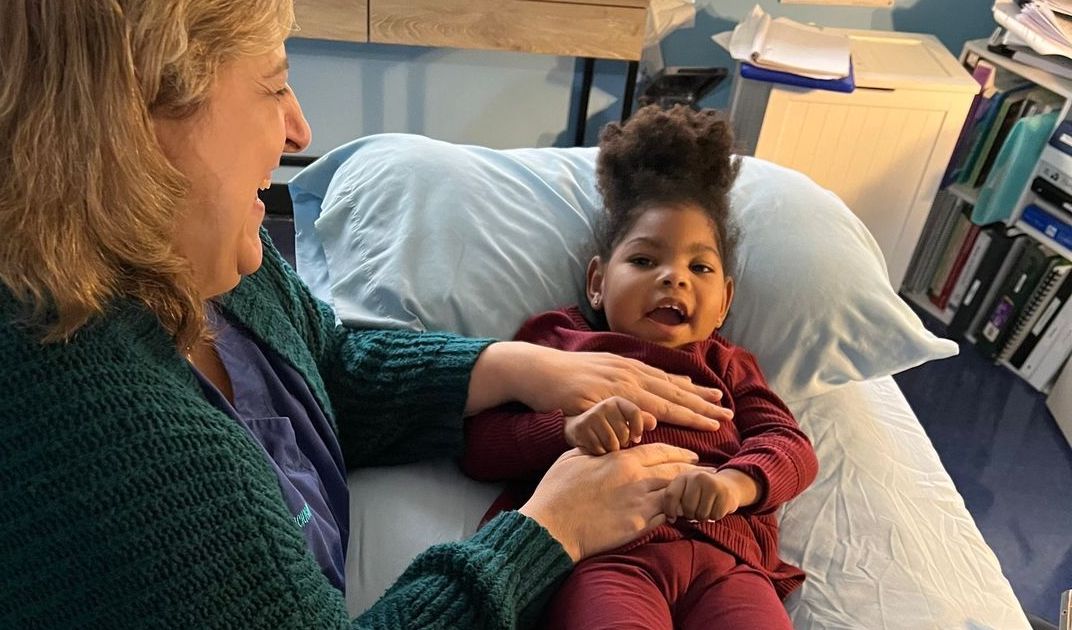Craniosacral Therapy (CST)

Craniosacral therapy (CST), our gentle and precise modality, focuses on releasing these restrictions with a feather-light touch, employing only 5 grams or less of pressure. Through this subtle yet profound approach, our therapists assess the symmetry, quality, amplitude, and rate of movement of cerebrospinal fluid in and around the central nervous system. It is a therapeutic art guided by deep expertise, where our role as therapists is to alleviate undue pressure, facilitating the natural movement of fluids and soft tissues. This assistance empowers the body to engage in self-correction, promoting natural healing processes.
Our journey begins…
with a comprehensive evaluation, an intricate exploration of a child’s unique occupational landscape. We embark on a meticulous analysis, discerning each child’s strengths and areas of deficit with utmost precision.

Conditions We Address
Craniosacral therapy’s gentle and non-invasive approach makes it a valuable complement to traditional treatments, offering holistic support for a wide range of pediatric conditions, including but not limited to:
Tongue, Lip, and Cheek Ties
Craniosacral therapy gently addresses tension and restrictions caused by tongue, lip, or cheek ties, promoting proper oral mobility. By releasing these restrictions, it enhances the baby’s ability to latch, breastfeed, and suck effectively, allowing for a smoother feeding experience.
Breastfeeding Issues
Craniosacral therapy supports breastfeeding by relieving tensions and restrictions in the baby’s body, especially in the head and neck region. This promotes a more comfortable latch and suck-swallow-breathe coordination, making breastfeeding a smoother and more enjoyable experience for both mother and child.
Torticollis and Plagiocephaly
Craniosacral therapy aids in resolving torticollis and plagiocephaly by addressing the underlying musculoskeletal imbalances and cranial distortions. It can restore symmetry, improve range of motion, and alleviate discomfort, allowing infants to develop proper head and neck positioning.
Sensory Processing Disorder (SPD)
Craniosacral therapy provides calming sensory input, supporting individuals with SPD. By addressing central nervous system imbalances, it helps regulate sensory responses, reducing hypersensitivity and promoting relaxation. This therapy aids in better processing and integration of sensory information.
Neurological Conditions
Addressing concerns like seizures, cerebral palsy, and Erb’s palsy to enhance motor function and coordination.
Craniosacral therapy offers gentle techniques that can assist individuals with neurological conditions. By promoting optimal cerebrospinal fluid flow and releasing tension in the nervous system, it supports overall neurological function, potentially enhancing mobility, balance, and overall comfort.
Digestive Disorders
Supporting children dealing with reflux, colic, and chronic ear infections.
Craniosacral therapy aids digestive disorders by addressing tension in the abdominal area. It promotes relaxation, supports healthy peristalsis, and aids in releasing abdominal discomfort. This therapy encourages a balanced digestive system, potentially alleviating symptoms related to various gastrointestinal issues.
Learning Disabilities and Emotional Challenges
Craniosacral therapy’s gentle approach can support individuals with learning disabilities and emotional challenges. By reducing overall tension and promoting relaxation, it creates a conducive environment for learning and emotional regulation. This therapy may contribute to increased focus, improved emotional resilience, and enhanced overall well-being.
Immune and Connective Tissue Disorders
Craniosacral therapy supports individuals with immune and connective tissue disorders by promoting relaxation and optimizing the body’s self-healing mechanisms. By addressing restrictions and imbalances, it aids in enhancing immune function and supporting the overall health of connective tissues, potentially improving the body’s resilience against illnesses and promoting physical comfort.
Healing Insights and Therapeutic Wisdom
What are primitive reflexes in infants?
Retained reflexes may be caused by c-sections, birth trauma, chronic ear infections, lack of tummy time, delayed or skipped crawling.
What is all this talk about craniosacral therapy (CST)? Does it work?
Craniosacral therapy (CST) is a gentle modality used to release restrictions in the fascia. The...
Tethered Oral Tissues (TOTs)
A tethered oral tissue or TOT, commonly known as a tie, is a tissue that is restricted, resulting...
Who Can Benefit
Craniosacral therapy can provide benefits to a variety of children with different needs and conditions. Here are some types of children who can benefit from craniosacral therapy:
Infants with Birth Trauma
Babies born with traumatic experiences, such as a difficult delivery or Cesarean section, can find relief through craniosacral therapy. This gentle approach helps release tension in the cranial and body tissues, promoting relaxation and easing discomfort.
Children & infants with Tongue, Lip, and Cheek Ties
Craniosacral therapy can aid in releasing restrictions caused by tongue, lip, and cheek ties. By addressing tension in the fascia, it promotes better oral function, helping with breastfeeding and overall oral motor skills.
Children with Headaches and Migraines
Craniosacral therapy can be effective in relieving tension in the head and neck, making it beneficial for children experiencing frequent headaches or migraines.
Children with Sleep Difficulties
Craniosacral therapy promotes relaxation, which can help children with sleep difficulties find a more restful and rejuvenating sleep.
Children with Learning Disabilities and Behavioral Challenges
Craniosacral therapy can provide emotional support to children with learning disabilities and behavioral challenges. By reducing stress and promoting relaxation, it can contribute to improved emotional regulation and overall well-being.
Children with Sensory Processing Disorders (SPD)
Craniosacral therapy supports children with SPD by calming the nervous system and reducing sensory sensitivities. This can lead to improved self-regulation and a better ability to cope with various sensory stimuli.
Children with Neurological Conditions
For children with neurological conditions like cerebral palsy or developmental delays, craniosacral therapy provides gentle support to the nervous system. It may help alleviate muscle tightness, improve motor function, and enhance overall neurological health.
Children with Traumatic Experiences
Craniosacral therapy is beneficial for children who have experienced trauma, whether physical or emotional. By releasing stored tension, it can aid in emotional healing and promote a sense of relaxation and security.
Children with Digestive Disorders
Craniosacral therapy can help children dealing with digestive issues by promoting relaxation in the abdominal area. It supports better gastrointestinal motility and may aid in reducing symptoms associated with conditions like colic or constipation.
Children with Learning Disabilities and Behavioral Challenges
Craniosacral therapy can provide emotional support to children with learning disabilities and behavioral challenges. By reducing stress and promoting relaxation, it can contribute to improved emotional regulation and overall well-being.
Children with General Tension and Stress
Even children without specific medical conditions can benefit from craniosacral therapy to reduce tension, stress, and promote relaxation, which can support their overall well-being.
It’s important to note that each child is unique, and craniosacral therapy plans are customized based on individual needs and goals. Whether a child faces developmental challenges, physical disabilities, or emotional struggles, craniosacral therapy can be tailored to provide targeted support and enhance your child’s overall quality of life.

Your First Appointment
We’ll go through multiple assessments with you and your child and create a goal-based treatment plan and home programming regimen in order to put your child on a positive path forward.
Read What Our Clients Are Saying
![]()
Schedule an Appointment Today
(248) 939-4030
We strive to answer your questions, address the issues you are facing, and enhance the quality of your life. Your individualized treatment will always be structured to meet 𝘺𝘰𝘶𝘳 needs and enhance 𝘺𝘰𝘶𝘳 wellness.
Our Pediatric Craniosacral Therapy Techniques
Somato Emotional Release (SER)
The core objective of SER is twofold: to enhance physical function and to usher in a profound sense of emotional ease, especially in high-charge situations. By releasing the stored trauma, children can experience increased mobility, reduced pain, and improved bodily function.
Visceral Manipulation
Visceral manipulation is meticulously designed to address restrictions that manifest within the body’s organs. These limitations can profoundly impact the organs’ inherent ability to eliminate toxins, promote healing, cleanse the body, and maintain essential homeostasis.





